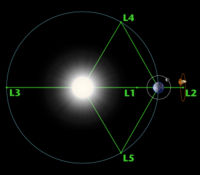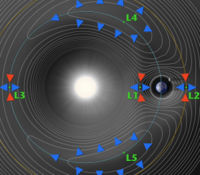Difference between revisions of "Solar Power"
(from Power page) |
Jarogers2001 (talk | contribs) (→Space Based Solar power: lagrange point images) |
||
| Line 1: | Line 1: | ||
| − | |||
An attractive source for power on the Moon is the Sun. Solar is particularly inviting in the polar regions where mountain tops are available that have solar views 75% to 99% of the time. The sun light is not diminished by an atmosphere and is never blocked by clouds. It is harsh and unrelenting. | An attractive source for power on the Moon is the Sun. Solar is particularly inviting in the polar regions where mountain tops are available that have solar views 75% to 99% of the time. The sun light is not diminished by an atmosphere and is never blocked by clouds. It is harsh and unrelenting. | ||
| Line 42: | Line 41: | ||
The distance from L1 to Luna is about the same as the distance from Earth to a geostationary satellite. | The distance from L1 to Luna is about the same as the distance from Earth to a geostationary satellite. | ||
| + | |||
| + | [[image:Lagrange_A.jpg|thumb|200 px|right|Lagrangian points in a two body system]] | ||
| + | [[image:Lagrange_B.jpg|thumb|200 px|right|Lagrangian points and force contour]] | ||
So one could put an SPS at lunar-L1 and beam microwaves from there to supply one or more rectennas on the Moon as a very efficient way to provide energy to a power hungry moon base. | So one could put an SPS at lunar-L1 and beam microwaves from there to supply one or more rectennas on the Moon as a very efficient way to provide energy to a power hungry moon base. | ||
Revision as of 12:49, 8 March 2007
An attractive source for power on the Moon is the Sun. Solar is particularly inviting in the polar regions where mountain tops are available that have solar views 75% to 99% of the time. The sun light is not diminished by an atmosphere and is never blocked by clouds. It is harsh and unrelenting.
From the surface of the Moon, the Sun appears to move slowly across the sky making a full cycle every 29 days. On rare occasions it is eclipsed by the Earth for a few minutes.
At the poles, the Sun simply circles the sky very near the horizon. At its lowest point it may be blocked by mountain tops. Other times it may be blocked by local instillations such as other power collectors.
Near the lunar equator, the Sun is visible only one half the time. The 14 day lunar nights are a major problem for power generation and are a major factor in setting a polar location for the first lunar settlement.
There are basically two types of solar power, Solar Dynamic (SD) and Photovoltaic (PV).
SD uses a heat cycle to drive a piston or a turbine which connects to a generator or dynamo. Two popular cycles for Solar Dynamic are Brayton Cycle or Stirling Cycle. Solar Dynamic systems employ a large reflector to focus sunlight to a high concentration to achieve a high temperature for the heat cycle to operate at highest possible efficiency.
PV uses semiconductors (e.g. Silicon or Gallium Arsenide) to directly convert sunlight photons into electric potential. Commonly know as “Solar cells”
Comparison of PV versus SD
PV Problems
The main problem with solar power is that PV conversion efficiency is only about 20% efficient, for rather high priced PV cells. Plus PV cells are rather heavy to ship from Earth and to soft land on Luna is very expensive.
SD Problems
SD has a much more severe pointing requirement than PV because it needs to maintain an accurate optical focus.
If a PV array drifts off a few degrees, the power level drops a few percent.
If a SD array drifts off a few degrees, the power level drops off to zero.
Space Based Solar power
Until ISRU manufacturing is online, Solar Power Satellites (SPS) represent a more economic means of supplying large scale basebar power on the Moon in the early days.
Compared to PV or SD systems, an SPS rectenna by itself is lightweight and has a conversion efficiency of over 90%.
Let us assume a PV array is 10 times heavier per watt than a rectenna.
That means we can get 5*10 = 50 times as much power per kilogram for a rectenna than for a PV array. That means a rectenna will be at least 50 times cheaper per watt of useful power than PV array. "At least" because the manufacturing cost of a rectenna will be much cheaper than for PV array.
Soft landing hardware on to the Moon is very expensive, so weight is at a premium.
The distance from L1 to Luna is about the same as the distance from Earth to a geostationary satellite.
So one could put an SPS at lunar-L1 and beam microwaves from there to supply one or more rectennas on the Moon as a very efficient way to provide energy to a power hungry moon base.
The sun angle across PV arrays on the lunar surface constantly changes, and is usually less than the 1,360 w/m^2. To maintain constant max power the PV array must have expensive and heavy steering equipment. Whereas a rectenna does not need to be steered, and always gets maximum power.
The ideal site for the lunar rectenna would be in Sinus Medii at the Lunar 0-Longitude point on the Lunar Equator, in the middle of the side which faces the Earth.
1) Because it is directly below the L-1 point, 2) it is the closest point on the lunar surface to the L-1 point, 3) Because at that point the lunar surface is at right angles to the incoming microwave beam.
All these factors permit the smallest rectenna at that location.
Without making any modifications at all to that very SPS, it could easily be maneuvered from L1 to GEO to feed a terrestrial ground based rectenna. The antenna design for L-1 to Luna will work equally well from GEO to Earth
| Work on this article has outpaced copyediting on it. You can help Lunarpedia by formatting, editing, or tidying it. |








